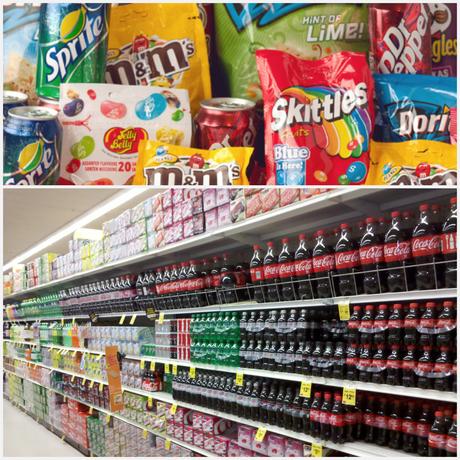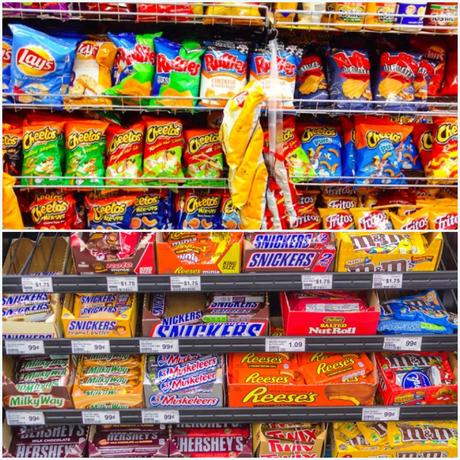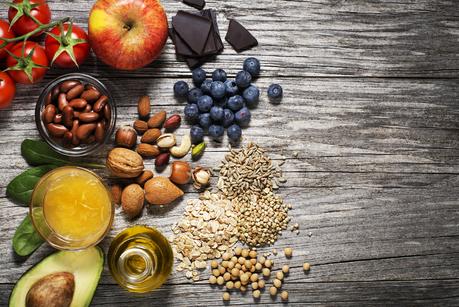
I recently got a question from a reader about what not to eat. She said, "Are there any foods that you'd say we should never eat, that are totally off limits?"
That got me thinking. In general, I don't advocate cutting out entire food groups or foods altogether. Instead, I like to promote the 80/20 rule or "everything in moderation." I think you can pretty much find a healthier version of just about anything (e.g. 88% dark chocolate instead of milk chocolate, sprouted grain bread instead of white bread, whole wheat pasta or lentil flour pasta instead of white pasta, etc.) I don't believe in diets, and I don't believe that entire food groups (e.g. gluten, dairy) are harmful unless you have an allergy or major intolerance to those foods.
But, after I received this question I realized while I don't advocate for cutting out entire food groups, there are certain ingredients in processed/packaged foods that I try to avoid at all costs. And when Mark Hyman reached out to me to chat about some of the advice in his newest book, I thought a joint post with some of his tips and some of mine would be the perfect way to answer this question.

Dr. Hyman likes to call processed foods "Frankenfoods" - that contain things like trans fats, high-fructose corn syrup (HFCS), monosodium glutamate (MSG), preservatives, pesticides, and antibiotics. Why the Frankenstein reference?
When I spoke to Dr. Hyman about this, he said, "Today's industrial food-like substances have hijacked our taste buds and brain chemistry. Food giants have taste institutes, where they hire "craving experts" to identify the "bliss points" of foods to create "heavy users." It's like manufacturing food that's like a drug - literally addicting! Even so-called healthy foods are hijacking our health. Manufacturers know that we're becoming more health-conscious, and they're staying three steps ahead of us with their food marketing. All the food labels on packaged products say things like "natural," "gluten free," "whole grain," "low-fat," - but these terms literally mean NOTHING. None of these labels indicate a food is healthy, and oftentimes if there are health claims on the label, what's inside is probably unhealthy!"
All of that can be so confusing when you're trying to figure out what to eat. In general, I advocate for sticking to real food - which lies in the periphery of our grocery stores. Real food doesn't usually have barcodes or ingredient lists. It doesn't claim to be "fat-free" or whatever health claims dominate the front of packaged foods. There are no preservatives to lengthen shelf life. They come nature-packaged with nutrients, not produced in labs using inferior versions of vitamins and minerals. When you eat a variety of real foods - things like fresh vegetables and fruits, wild-caught fish, nuts and seeds - you naturally get the right amount of protein, fiber, and other health-sustaining nutrients.

Most of what we eat is not "real food." At least, it has been so adulterated and processed, it is more of a food-like substance. Look at pretty much any processed food and you'll find dozens of ingredients. The front label might have some bold health claims, but its ingredients show otherwise. As a result, most of us are confused, not knowing whom to believe or what to eat. It can be so frustrating! And while I definitely don't advocate cutting out all packaged foods altogether, there are 10 ingredients I absolutely avoid if I see them on the label.
So here it is: My Top 10 Worst Ingredients in Processed Food! #1 | High Fructose Corn Syrup (other names it goes by: glucose syrup, corn sugar, fruit fructose, iso-glucose).What it is: a highly refined sweetener made from corn starch.
Why it's bad: It has been shown to contribute to weight gain, diabetes, cardiovascular disease, arthritis, insulin resistance, elevated triglycerides and LDL cholesterol.
It's found in: Soda, salad dressings, breads, cereals, yogurt, soups, canned vegetables, lunch meats, pizza sauce and condiments.
#2 | Trans Fat or Hydrogenated Vegetable Oil (other names it goes by: shortening, partially hydrogenated [soy, palm, corn, etc.] oil).
What it is: Trans fats are created when a regular fat like corn, soybean, or palm oil is blasted with hydrogen and turned into a solid. Trans fats help packaged foods retain a longer shelf life (it doesn't go bad for years!)
Why it's bad: Trans fats raise your LDL (bad) cholesterol and lower your HDL (good) cholesterol. They contribute to heart disease, obesity, strokes, and increase your risk of metabolic syndromes.
#3 | Artificial Food Coloring / Food Dyes (other names it goes by: Blue 1 and 2 - E133, green 3, red 3, red 40 and yellow 6 - E110, yellow tartrazine - E102)It's found in: Deep fried foods, margarine, chips, crackers, baked goods, fast food
What it is: These make foods look bright and colorful (much brighter than they would look in nature!)
#4 | Artificial Sweeteners (other names it goes by: Aspartame, Equal, Sucralose, Splenda, Saccharin, Sweet N Low, NutraSweet)Why it's bad: Artificial food coloring has been banned in Europe for a while now, as they have been linked to various cancers, chromosomal damage, and behavioral problems (ADD/hyperactivity) in kids
It's found in: Fruit juices, salad dressings, cocktail mixes, pie mixes, ice cream, candy, bakery products, American cheese, mac & cheese, soda, lemonade, kids' medication, energy bars, cereal, fast food, frosting, puddings, jams, meat & fish (to make them appear "fresher") and more!
What it is: A chemical that adds sweetness to food without adding calories to food
Why it's bad: Many artificial sweeteners are believed to be carcinogenic, and can contribute to headaches and digestive issues. It also messes with your metabolism and insulin because they trick the brain into forgetting that sweetness means extra calories, which can cause people to actually eat more sweet foods over time! Also, when you eat something that's artificially sweetened, your body releases insulin the way it would if you actually ate sugar - which messes with your body's insulin response over time.
It's found in: Over 6,000 products - including diet/sugar-free sodas and drinks, gum, yogurt, mints, instant breakfasts, dessert, low calorie drinks, toothpaste
#5 | MSG - Monosodium Glutamate (other names it goes by: Yeast Extract, Hydrolyzed Vegetable Protein, Hydrolyzed Plant Protein, Vegetable Protein Extract, Glutamate, Glutamic Acid, Sodium Caseinate, Textured Protein, Soy Protein Isolate, Barley Malt, Calcium Caseinate and Malt Extract)
#6 | Sodium Nitrite and Sodium NitrateWhat it is: MSG is an amino acid used as a flavor-enhancer in processed foods. It is used to make foods more "addicting" to keep you eating/buying those foods!
Why it's bad: Regular consumption of MSG has been shown to stimulate the appetite and contribute to weight gain and obesity. It can also cause fatigue and headaches.
It's found in: Many processed foods like pre-made salad dressings, low-fat flavored yogurt, canned meats, frozen dinners, chips, canned soups, Chinese Food, cookies, seasonings, lunch meats.
#7 | BHA & BHT (Butylated hydroxyanisole (BHA) and butylated hydrozyttoluene (BHT))What it is: These two chemicals are used to preserve meat and also give it a nice, vibrant color
Why it's bad: When added to meat, these nitrates convert to nitrosamines, which are associated with an increased risk of certain cancers - and this conversion usually happens at high temperatures. In a 2007 analysis, The World Cancer Research Fund revealed that eating 1.8 ounces of processed meat every day increases your cancer risk by 20%.
It's found in: Bacon, ham, salami, corned beef, hot dogs, pate, pickled pig's feet, canned meat, smoked salmon, dried fish, jerky, lunch meat, cured meats and other processed meats.
What it is: These are two preservatives used to extend shelf life and keep foods from becoming rancid.
Why it's bad: Both of these preservatives have been deemed potentially carcinogenic to humans and the State of California has listed them as a known carcinogen. They can also mess with your hormones.
It's found in: Cereals, packaging materials, sausage, hot dogs, gum, chips, beer, butter, vegetable oils, shortening, candy, jello, cosmetics.
#9 | rBGH and rBST (Recombinant Bovine Growth Hormone (rBGH), Recombinant bovine somatotropin (rBST))#8 | Potassium Bromate (other names it goes by: bromic acid, potassium salt, bromated flour, "enriched flour")
What it is: This is a food additive used to increase the volume in breads, rolls, flour
#10 | Artificial FlavorsWhy it's bad: It has been banned in the EU, Canada and several other countries because it has been shown to cause cancer in animals. It is also an endocrine disruptor.
It's found in: Most commercial breads (e.g. Wonder Bread, Home Pride). It's also common in flour so check the ingredients before you buy!
What it is: These are growth hormones designed to boost milk production in dairy cows.
Why it's bad: Milk from cows given these hormones have high levels of insulin-like growth factor (IGF-1). High levels of this have been linked to breast, colon and prostate cancers. Additionally, giving cows rBGH has been shown to increase the incidence of mastitis - which requires high levels of antibiotics to be given to the cows. rBGH milk is not required to be labeled.
For more information on which foods are beneficial and which to avoid, check out Mark's new book - Food: What the Heck Should I Eat?It's found in: All dairy products that aren't specifically labeled "No rGBH or rBST."
What it is: Chemical compounds used to flavor foods and make them more addicting
Why it's bad: Artificial flavors on their own aren't harmful, but they are often an indicator that the food is highly processed and likely includes one of the other ingredients on this list! Real food doesn't require artificial flavoring to taste good it tastes great all on its own!
It's found in: Candy, soda, fast food, and other processed foods.
So what shouldyou eat? Stick to whole foods (the perimeter of the grocery store!) and only buy packaged foods where: 1) you can pronounce all of the ingredients on the label (e.g. nut butter should just have nuts and salt listed, nothing else) and 2) none of these 10 ingredients are listed on the label! I hope this list helps you navigate those confusing grocery store aisles, and help you find the healthiest food for you and your family!

